
DEAN’S REPORT 2023-24
Dean Mario Eden
Director, Communications and Marketing
Austin Phillips
Editor
Cassie Montgomery
Contributors
Wade Berry
Dustin Duncan
Jeremy Henderson
Joe McAdory
Carla Nelson
Graphic Design
Danny Doyle
Web Manager
Tyler Patterson
Photography
Marcus Kluttz
John Sluis
2023-24 Dean’s Report
The Dean’s Report is published annually by Auburn University’s Office of Engineering Communications and Marketing.
Engineering Communications and Marketing 1210 Shelby Center Auburn, AL 36849 eng.editor@auburn.edu 334-844-2444
© 2024 Samuel Ginn College of Engineering, Auburn University.
Auburn University is an equal opportunity educational institution/employer.
oceans and lakes from phosphorus runoff
Reimagining sustainable development of plastic materials
Safeguarding the Gulf Coast Ecosystem
25 Computer Science and Software
Combating cancer subtype misdiagnoses with data science
26 Electrical and Computer
Exploring security solutions for semiconductor supply chains
27 Industrial and Systems
Predicting additive manufacturing fatigue through deep learning
28 Materials
Synthesizing 2D materials for novel energy applications
29 Mechanical
Auburn center’s FHE reputation underscored with multiple winning additively manufactured electronics proposals
Using functional data analysis-aided learning methods to improve wireless measurements
3 Dean’s Message 4 By the Numbers 10 College Leadership 12 Huntsville Happenings 14 Embodying the Mission Department Highlights 18 Aerospace
20 Biosystems
22 Chemical
Materials studies lead to early faculty career awards
Protecting
24
Civil and Environmental
30 Wireless
32 Faculty Highlights 34 New Faculty Members 36 Student Highlights 40 Ensuring Engineering’s Future 41 Student Support 42 Research Centers 2 SAMUEL GINN COLLEGE OF ENGINEERING
CONTENTS
DEAN’S MESSAGE
Time flies.
It’s hard to believe this academic year has come to a close, along with my first year serving as dean of the Samuel Ginn College of Engineering.
But what a year it’s been.
In January, we signed the single largest prime research contract in Auburn University history designed to help the U.S. Army Combat Capabilities Development Command Aviation & Missile Center boost its increasing modernization efforts.

In March, the Food and Drug Administration approved our new Terra.X 7 Tesla MRI machine, the first fieldinstalled, clinical parallel transmit scanner in the world. This cutting-edge technology will expand our research, emphasizing cardiovascular, orthopedic and brain imaging.
From Auburn to Huntsville to Washington D.C., our footprint and impact continues to grow across the nation. We recently entered into an agreement with the Space Development Agency (SDA) that will allow our Auburn University Research and Innovation Campus in Huntsville to become a base of technical support operations for the SDA, the sole arm of the U.S. Space Force operating in Alabama. In addition to logistical support, the partnership will provide opportunities for collaboration between the SDA and the Auburn University Applied Research Institute located within the Huntsville facility.
This year, we also surpassed record enrollment, scholarships and research, including more than $90 million in new awards and grants.
Auburn Engineering is chartering a course for the future that continues to set records and provide the best student-centered engineering experience in America.
War Eagle!
Mario R. Eden
OUR VISION
To be the best student-centered engineering experience in America
To provide leading research that improves the quality of life and fosters economic competitiveness
To be a dynamic faculty and staff that exemplifies excellence and innovation
3 DEAN’S REPORT 2023-24
NATIONAL RANKINGS
30 th undergraduate program ranking among public universities1
31 st graduate engineering program ranking among public universities1
19 th
49 th
34 th
ranking in number of engineering bachelor’s degrees awarded2
1 st online computer science bachelor’s program3
29 th 19 th undergraduate enrollment among public universities2
national ranking in undergraduate degrees awarded to women2 best online master in engineering program1
23 rd
graduate online program ranking among all engineering colleges1 best online information technology program1
4 SAMUEL GINN COLLEGE OF ENGINEERING
BY THE NUMBERS
national
1 U.S. News & World Report rankings | 2 2022 American Society for Engineering Education | 3 Best Colleges
GRADUATE STUDENTS BY PROGRAM UNDERGRADUATE STUDENTS BY PROGRAM
12.5%
1 Includes African American, Hispanic, American Indian or Alaska Native, Native Hawaiian or Pacific Islander students or students of two or more races, per the National Science Foundation
5 DEAN’S REPORT 2023-24
Aerospace Biosystems Chemical Civil and Environmental Computer Science and Software Electrical and Computer Industrial and Systems Materials Mechanical Wireless Pre-engineering ENROLLMENT
female students
23%
underrepresented students 1
Auburn undergraduate students 5,214 674 179 444 535 1,125 510 446 33 1,196 13 59 18% of Auburn graduate students 19% of Auburn student body 1,117 6,331 Aerospace Biosystems Chemical Civil and Environmental Computer Science and Software Cybersecurity Data Electrical and Computer Master of Engineering Engineering Management Industrial and Systems Materials Mechanical Polymer and Fiber MASTER’S DOCTORAL 37 48 BASE: 100 12 16 25 12 83 60 72 61 92 71 112 17 35 26 19 87 48 6 53 (1 masters / 1 doctoral) 93 Chart does not include graduate non-degree.
19% of
CLASS SNAPSHOT Fall 2023
1,362 first-time students 28.8
UNDERGRADUATE ENROLLMENT
GRADUATE ENROLLMENT GRADUATE SNAPSHOT
495 master’s 592 doctoral 30 certificate
23% female students
6 SAMUEL GINN COLLEGE OF ENGINEERING 2014 2015 2016 2017 2018 2019 2020 2021 2022 2023 1,116 921 851 899 976 942 1,003
FRESHMAN
214
average high
average ACT
transfer students 4.15
school GPA
2014 2015 2016 2017 2018 2019 2020 2021 2022 2023 5,386 4,618 4,968 4,963 5,282 5,559 5,579 5,153 5,068 5,214 1,176 1,150 1,117
7 DEAN’S REPORT 2023-24
tenured/tenure track faculty > $90 MILLION in new awards and grants 2013 $61.3 2014 $60.0 2015 $58.3 2016 $61.7 2017 $62.6 2018 $64.3 2019 $65.6 2020 $72.9 2021 $78.2 2022 $86.0 2023 $87.3 21 postdoctoral researchers/fellows 67
track teaching/research faculty Advanced Manufacturing and Materials Infrastructure and Transportation Cybersecurity and Intelligent Systems
and Environment
and Health Systems STRATEGIC RESEARCH AREAS RESEARCH SNAPSHOT RESEARCH EXPENDITURES (in millions) FACULTY SNAPSHOT
190
non-tenure
Energy
Biomedical
Advanced Manufacturing: $20,386,983
Transportation Engineering: $17,953,771
Additive Manufacturing: $7,429,643
Autonomy and Assured Positioning, Navigation and Timing: $4,603,937
Micro and Nano Electronics: $3,639,215
Biomedical and Health Systems Engineering: $2,322,956
RESEARCH AWARD HIGHLIGHTS 2023
$6,552,227
Federal Transit Administration
“Low and No Emission-Component Assessment” Christian Brodbeck (engineering administration) and Mark Hoffman (mechanical engineering)
$3,255,444
State of Kansas
“Additive Manufacturing Material and Process Rapid Qualification for Vehicle Applications” Nima Shamsaei and Shuai Shao (mechanical engineering)
$1,250,000
National Asphalt Pavement Association
“Synthesis of State of Practice and Research Needs for Airfield Asphalt Pavement Resilience” Benjamin Bowers (civil and environmental engineering)
$1,099,000
Trideum Corporation
“Missions based multi-domain operations test environment” Stephen Mills (Applied Research Institute) and Hunter Burch (electrical and computer engineering)
$3,012,027
United States Air Force
“Novel Timber Structures for Air Force Expeditionary Environments” James Davidson, J. Brian Anderson, David Roueche and Kadir Sener (civil and environmental engineering)
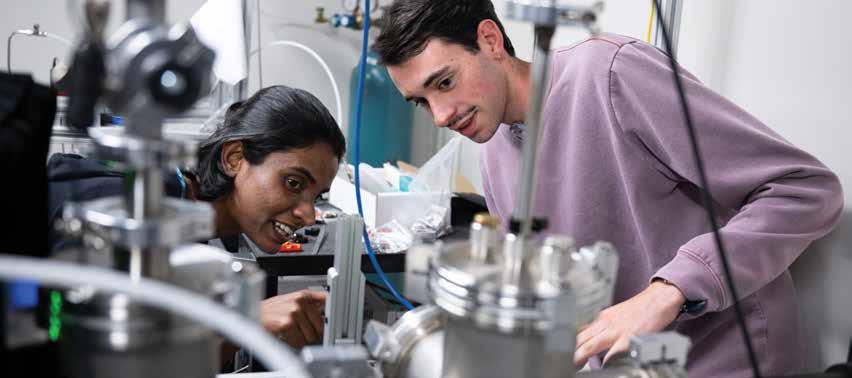
8 SAMUEL GINN COLLEGE OF ENGINEERING
HIGH PROFILE RESEARCH AREAS Funding awarded in 2023
ACADEMIC DEPARTMENTS AND DEGREES
AEROSPACE ENGINEERING
Bachelor of Aerospace Engineering
Master of Science in Aerospace Engineering
Ph.D. in Aerospace Engineering
BIOSYSTEMS ENGINEERING
Bachelor of Biosystems Engineering
Bachelor of Biosystems Engineering
Ecological Engineering Option
Bachelor of Biosystems Engineering
Forest Engineering Option
Bachelor of Biosystems Engineering
Bioprocess Engineering Option
Master of Science in Biosystems Engineering
Ph.D. in Biosystems Engineering
CHEMICAL ENGINEERING
Bachelor of Chemical Engineering
Master of Science in Chemical Engineering
Ph.D. in Chemical Engineering
CIVIL AND ENVIRONMENTAL ENGINEERING
Bachelor of Civil Engineering
Master of Science in Civil Engineering
Master of Civil Engineering
Ph.D. in Civil Engineering
COMPUTER SCIENCE AND SOFTWARE ENGINEERING
Bachelor of Computer Science
Bachelor of Science in Computer Science
Bachelor of Software Engineering
Master of Science in Artificial Intelligence Engineering
Master of Science in Computer Science and Software Engineering
Master of Science in Cybersecurity Engineering
Ph.D. in Computer Science and Software Engineering
ELECTRICAL AND COMPUTER ENGINEERING
Bachelor of Electrical Engineering
Bachelor of Computer Engineering
Master of Science in Electrical Engineering
Ph.D. in Electrical Engineering
INDUSTRIAL AND SYSTEMS ENGINEERING
Bachelor of Industrial and Systems Engineering
Master of Science in Industrial and Systems Engineering
Master of Industrial and Systems Engineering
Master of Engineering Management
Ph.D. in Industrial and Systems Engineering
MATERIALS ENGINEERING
Bachelor of Materials Engineering
Master of Science in Materials Engineering
Ph.D. in Materials Engineering
MECHANICAL ENGINEERING
Bachelor of Mechanical Engineering
Master of Science in Mechanical Engineering
Ph.D. in Mechanical Engineering
INTERDEPARTMENTAL PROGRAMS
Master of Engineering
Master of Science in Polymer and Fiber Engineering
Master of Science in Data Science and Engineering – Interdisciplinary
Ph.D. in Polymer and Fiber Engineering
Ph.D. in Earth System Science – Interdisciplinary
9 DEAN’S REPORT 2023-24
LEADERSHIP

Mario Eden Dean

Brian Thurow Aerospace Engineering Chair

Mark Nelms Electrical and Computer Engineering Chair

Allan David Associate Dean for Research

Oladiran Fasina Biosystems Engineering Head
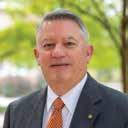
Gregory Harris Industrial and Systems Engineering Chair

Maria Auad Associate Dean for Graduate Studies and Faculty Development

Selen Cremaschi Chemical Engineering Chair

Jeff Suhling Mechanical Engineering Chair

Jeffrey Fergus Associate Dean for Undergraduate Studies and Program Assessment
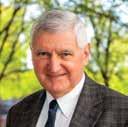
Andrzej Nowak Civil and Environmental Engineering Chair
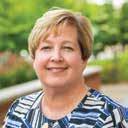
Janet Moore Assistant Dean for Student Services

Hari Narayanan Computer Science and Software Engineering Chair
AUBURN ALUMNI ENGINEERING COUNCIL 2023-24 EXECUTIVE COMMITTEE
Brad Christopher Chair
Gerald Pouncey Vice Chair
Shirley Boulware At Large
Jim Cooper At Large
Nicole Faulk Nominating
Maury Gaston Government Affairs
Carol Godfrey Diversity and Inclusion
Melissa Herkt Young Alumni Council Liaison
Kenneth Kelly Immediate Past Chair
Mark Miller Research
Larry Monroe At Large
Bobby Keith Development
Ashely Robinett At Large
Ken Smith Academics and Student Experience
Jeff Stone Capital Campaign Committee
K-Rob Thomas Public Relations
Walt Woltosz Second Past Chair
10 SAMUEL GINN COLLEGE OF ENGINEERING
FELLOWS IN THE COLLEGE OF ENGINEERING
AEROSPACE ENGINEERING
John Cochran
American Institute of Aeronautics and Astronautics (AIAA)
Roy Hartfield
American Society of Mechanical Engineers (ASME)
Joe Majdalani AIAA
BIOSYSTEMS ENGINEERING
William Batchelor
American Society of Agricultural and Biological Engineers (ASABE)
Oladiran Fasina
ASABE
Steven Taylor
ASABE
CHEMICAL ENGINEERING
Harry Cullinan
Technical Association of the Pulp and Paper Industry
Thomas Hanley
American Institute of Chemical Engineers (AIChE)
Elizabeth Lipke
American Institute for Medical and Biological Engineering (AIMBE)
Joseph Shaeiwitz
AIChE; American Society of Engineering Education (ASEE)
Bruce Tatarchuk
National Academy of Inventors (NAI)
CIVIL AND ENVIRONMENTAL ENGINEERING
Robert Barnes
American Concrete Institute (ACI)
Xing Fang
American Society of Civil Engineers (ASCE); Environmental and Water Resources Institute
Andrzej Nowak
ASCE; ACI, International Association for Bridge and Structural Engineering; Precast/ Prestressed Concrete Institute (PPCI)
Anton Schindler
ACI; ASCE
Huaguo Zhou
Institute of Transportation Engineers
COMPUTER SCIENCE AND SOFTWARE ENGINEERING
Daniela Marghitu
Society for Design and Process Science
Levent Yilmaz
Society for Modeling and Simulation International
ELECTRICAL AND COMPUTER ENGINEERING
Prathima Agrawal
Institute of Electrical and Electronics Engineers (IEEE)
Vishwani Agrawal
IEEE
Fa Foster Dai
IEEE; NAI
Charlie Gross
IEEE
Mark Halpin
IEEE
John Hung
IEEE
Dave Irwin
IEEE; NAI
Dick Jaeger
IEEE
Hulya Kirkici
IEEE
Shiwen Mao
IEEE
Mark Nelms
IEEE
Adit Singh
IEEE
Jitendra Tugnait
IEEE
Dan Wilamowski
IEEE
John Wu
IEEE
INDUSTRIAL AND SYSTEMS ENGINEERING
John Evans
Luminary, Surface Mount Technology Association (SMTA)
Sean Gallagher
American Industrial Hygiene Association (AIHA); Human Factors and Ergonomics Society
Chan Park
Institute of Industrial and Systems
Engineers (IISE)
Jeff Smith IISE
Alice Smith
IISE; IEEE; Institute for Operations Research and Management
Science
Rob Thomas
AIHA
MECHANICAL ENGINEERING
Mehmet Arik
NAI
Bryan A. Chin
ASM International; American Nuclear Society; American Welding Society; Electrochemical Society
Malcolm Crocker
Acoustical Society of India; Acoustical Society of America
Jeffrey Fergus
Electrochemical Society; ABET
George Flowers
ASME
Rob Jackson
ASME
Jay Khodadadi
Associate AIAA; ASME
Pradeep Lall
Alabama Academy of Sciences; Institute of Electrical and Electronics Engineers; ASME; NextFlex
P. K. Raju
ASME; American Society of Engineering Education; Acoustical Society of India;
The Institution of Engineers, India
Subhash Sinha
ASME; Associate AIAA
Jeffrey Suhling
ASME
Hareesh Tippur
Society of Experimental Mechanics; ASME
11 DEAN’S REPORT 2023-24
HUNTSVILLE HAPPENINGS
BY JEREMY HENDERSON
AUBURN UNIVERSITY APPLIED RESEARCH INSTITUTE TO OVERSEE $50M ARMY ADVANCED MANUFACTURING PROJECT — THE LARGEST RESEARCH CONTRACT IN UNIVERSITY HISTORY
How much is Auburn University’s advanced manufacturing expertise worth to the U.S. Army? The answer is up to $50 million.
That’s the total of a new three-year project — the single largest prime research contract ever awarded to Auburn University — designed to help the U.S. Army Combat Capabilities Development Command Aviation & Missile Center boost its increasing modernization efforts.
Titled “Lightweight, Advanced Manufacturing of Metallic, Polymer and Composite Structures for Aviation and Missile Weapon Systems,” the project will be facilitated through the Auburn University Applied Research Institute (AUARI) in Huntsville and rely extensively on research expertise from Auburn’s National Center for Additive Manufacturing Excellence (NCAME), and the Interdisciplinary Center for Advanced Manufacturing Systems.
“Our main objective is to enable the Army to incorporate advanced manufacturing materials and methods into existing and future aviation and missile systems,” said Robert Dowling, AUARI director of research development.
“To do that, we’ll develop prototype advanced manufacturing processes required to analyze, design, develop, test, integrate and sustain qualified components for existing and future aviation and missile systems. The advanced manufacturing materials we’re considering include alloys, polymers and composites. The methods will include everything from machine learning to material properties characterization.”
Specific to the latter, $9.3 million of the award has already been designated for NCAME, which will use the funds to continue its industry-leading research into the materials, parts and process qualification necessary for furthering implementation of additive manufacturing in Army operations.
“While existing and future aviation and missile systems will be the direct beneficiaries of the project, successful results may be transferable to other government advanced manufacturing projects,” Dowling said. “A lot of effort has gone into developing this opportunity. We’re excited to get to work.”
Steve Taylor, Auburn University’s senior vice president for research and economic development, agrees.
“It goes without saying, but this is a significant accomplishment for Auburn’s research enterprise and our Applied Research Institute,” Taylor said. “It also speaks volumes about how our Army partners in Huntsville, and beyond, are placing significant value on Auburn’s work in advanced manufacturing, which is a key research focus area for our Samuel Ginn College of Engineering. To say it’s paying off is an understatement.”
Dowling also calls the project tailor-made for fulfilling one of the AUARI administration’s stated goals — creating a pipeline for real-time engagement between stakeholders in Huntsville’s defense sector and Auburn main campus.
“With this award, we’ve demonstrated the significant opportunities that can be created for faculty and students when we combine our core research expertise with customer proximity and knowledge,” Dowling said. “AUARI’s proximity to Redstone Arsenal and familiarity with Army customers and missions enabled the AUARI team to develop a highly responsive proposal representing a broad spectrum of Auburn’s research capabilities both oncampus and in Huntsville.”
In other words, mission accomplished.
“President Chris Roberts’ vision for Auburn is built around dreaming bigger, being bolder and pushing our research endeavors to the next level,” Taylor said. “This historic award does exactly that.”
12 SAMUEL GINN COLLEGE OF ENGINEERING

SPACE DEVELOPMENT AGENCY PARTNERS WITH AUBURN UNIVERSITY RESEARCH AND INNOVATION CAMPUS FOR LOGISTICAL SUPPORT
Auburn University is making space for the Space Development Agency (SDA).
Located just outside Redstone Arsenal in Huntsville, the new Auburn University Research and Innovation Campus (AURIC) is set to become a base of technical support operations for the SDA, the sole arm of the U.S. Space Force operating in Alabama.
In addition to logistical support, the partnership will provide opportunities for collaboration between the SDA and the Auburn University Applied Research Institute located within AURIC.
“This new phase of Auburn’s relationship with the SDA is especially rewarding because it perfectly aligns with the original vision for the Auburn University Research and Innovation Campus,” said Steve Taylor, senior vice president for research and economic development. “We designed this cutting-edge campus not only to facilitate research but to be the go-to destination for government and industry entities within Redstone looking to accommodate and even train their workforce.”
Taylor is especially pleased that the first outside entity to raise its flag over AURIC is space focused.
“Auburn’s reputation for helping the nation remain the dominant power in space is pretty well known,” Taylor said. “Our relationship with NASA, of course, is practically second to none among universities. We have also collaborated with the Missile Defense Agency and Space and Missile Defense Command on Redstone to support their efforts to defend our nation.
“This partnership with the Space Development Agency is yet another important step for Auburn as we strengthen our ties with the U.S. Space Force and help it accomplish its mission.”
SDA Director Derek Tournear agrees.
“SDA is committed to empowering our talented team of professionals to deliver needed space-based capabilities to the joint warfighter through development, fielding and operation of the Proliferated Warfighter Space Architecture in low-Earth orbit,” Tournear said.
“We are grateful for this collaboration with the Auburn University Research and Innovation Campus, which provides essential office space for SDA personnel located near the SDA Space Operations Center-South at Redstone Arsenal.”
13 DEAN’S REPORT 2023-24
EMBODYING THE MISSION

RESEARCH
BY JOE MCADORY
DEMONSTRATING HIGH-POWER BATTERIES FOR NEXT-GENERATION DEFENSE APPLICATIONS
Auburn University and IntraMicron Inc., a partnering engineering technology development company, showcased a revolutionary means to safely meet the extreme demands of pulse-power electrical systems tailored for next-generation defense missions at a special demonstration in December. There, guests witnessed emulated pulse-power mission load discharges powered by a cutting-edge, 1,000-volt lithium-ion battery pack, as part of the team’s ongoing efforts to enhance the nation’s national security and defense posture.
“We have one of the world’s largest lithium-ion batteries that can discharge safely at higher, or faster, power levels than any other lithium-ion battery system available,” said Bruce Tatarchuk, IntraMicron co-founder and CEO who serves as director of Auburn University’s Center for Microfibrous Materials Manufacturing and the Charles Gavin III Endowed Professor in the Department of Chemical Engineering.
This innovative system is designed with maximum safety precautions to prevent battery propagation failures, Tatarchuk said, while enabling cells to operate at peak current and power outputs. Leveraging thermal
management, this battery-thermal technology enables up to a four-fold increase in power density, setting the stage for next-generation pulse power requirements. Thermal energy storage provides a high-density, consistent cooling capability for directed energy or other mission systems and power requirements.
“From a research standpoint, we at Auburn University focus heavily on societal impact and improving the quality of life, driving our economy and securing our nation,” said Steve Taylor, vice president for research and economic development at Auburn University.
“There’s a significant amount of national security work that Auburn does across engineering, science, math and veterinary medicine. IntraMicron is a part of that overall effort in manufacturing, helping to make sure that we have the appropriate industrial base in this country to defend our economy. Making strategic investments in research faculty, making investments in our campus research infrastructure and making investments in research programs can produce technology we need to defend ourselves. And, in this case, continue to drive our economy forward and keep America safe.”
14 SAMUEL GINN COLLEGE OF ENGINEERING

OUTREACH
BY DUSTIN DUNCAN
HELPING COMMUNITIES MEET TRANSPORTATION NEEDS THROUGH PARTNERSHIP
Jeff LaMondia, a professor of civil and environmental engineering, has been instrumental in empowering numerous small communities in Alabama to address their distinctive local active transportation needs.
Fortunately for Alabama, LaMondia will continue working with communities to promote safe/ accessible active travel and improve access to healthier foods through a five-year, $4.4 million grant from the Centers for Disease Control and Prevention (CDC) in collaboration with the Alabama Cooperative Extension System (ACES) Live Well Alabama Thriving Communities team.
This work builds upon a previous multi-year, multimillion-dollar grant from the CDC as part of its High Obesity Program (HOP), which supports land-grant universities to work through cooperative Extension programs in counties where the adult obesity rate exceeds 40%.
Their previous work not only generated community action plans and improved transportation infrastructure, but the team received the 2023 National Technology Transfer Leadership Award from the Council of
University Transportation Centers for their outreach work.
LaMondia, co-investigator on the grant, is teaming with Katie Funderburk, assistant director for Federal Nutrition Programs, Ruth Brock, Thriving Communities program coordinator and Mitch Carter, Thriving Communities specialist.
The Thriving Communities team will collaborate with Alabama Extension County offices and county coalitions to implement evidence-based initiatives to improve access to healthier foods and promote safe and accessible physical activity.
Thriving Communities will focus on addressing health disparities related to poor nutrition, physical activity and obesity in 12 Alabama counties: Barbour, Bullock, Butler, Escambia, Etowah, Greene, Hale, Marengo, Perry, Russell, Sumter and Wilcox.
Smaller communities are well-positioned to undertake transportation projects with just a bit of assistance because there are numerous opportunities to create sidewalks, crosswalks and bike lanes, LaMondia said.
15 DEAN’S REPORT 2023-24

TEACHING
BY CARLA NELSON
INSPIRING UNDERGRADUATES THROUGH INNOVATIVE TEACHING
Erin Garcia, a lecturer in the Department of Industrial and Systems Engineering (ISE), was honored in November with the Alumni Undergraduate Teaching Excellence Award at Auburn University’s 17th annual Faculty Awards ceremony. The award recognizes the outstanding teaching of undergraduates. Each year, Auburn recognizes its faculty members’ achievements in teaching, research, creative scholarship and outreach with several honors.
Garcia has taught eight different undergraduate classes for the department and a new course this past spring. Industrial and systems engineering faculty members Yadrianna Acosta-Sojo and Greg Purdy also submitted letters of recommendation.
“She will make sure that she is available to answer the questions of the students who can’t quite get something right by hosting additional office hours,” Acosta-Sojo wrote. “She will also have multiple communication channels for the students to connect with her and answer questions. Dr. Garcia’s contributions go far beyond her instructional responsibilities.”
In his nomination letter, Purdy told the selection
committee that Garcia is the epitome of what this award strives to recognize.
“She always provides the highest quality educational experience in the classroom and constantly evolves her pedagogy to provide new opportunities for students to connect with the material,” he wrote.
“Erin has a remarkable ability to foster a dynamic and inclusive learning environment, inspiring students to reach their full potential. Her dedication to teaching excellence has a profound and lasting impact — not only on the students she mentors — but also on our academic community as a whole. Erin’s impact extends far beyond the classroom and has left an indelible mark on our entire department.”
“While winning the award was an incredible honor that I am grateful for, it is the nomination from my students that means the most to me. I am grateful for their support and encouragement, and the nomination is the best compliment they could have given me about my teaching and the value that they also place on the relationships we have built while they complete their studies,” Garcia said.
16 SAMUEL GINN COLLEGE OF ENGINEERING
FACULTY AND STAFF THAT EXEMPLIFY EXCELLENCE AND INNOVATION
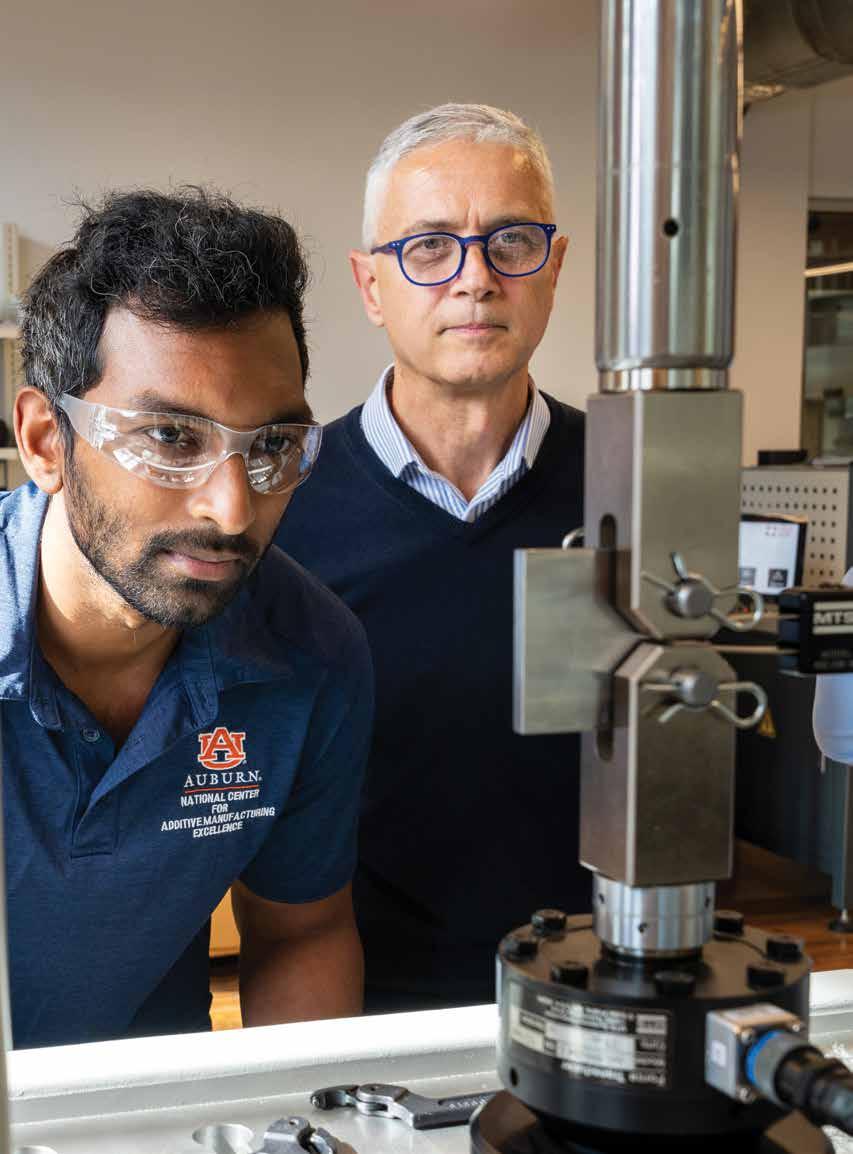

AEROSPACE
MATERIALS STUDIES LEAD TO EARLY FACULTY CAREER AWARDS
BY DUSTIN DUNCAN
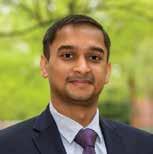
Vinamra Agrawal
Assistant Professor 334-844-5110
Vza0013@auburn.edu
aub.ie/VAgrawal
Two assistant professors in the Department of Aerospace Engineering were recently awarded prestigious early career awards for their research.
Vinamra Agrawal earned a faculty early career development grant from the National Science Foundation and Davide Guzzetti was awarded a NASA Early Career Faculty grant.
NANOCRYSTALLINE ALLOYS IN HARSH ENVIRONMENTS
Agrawal’s award, titled “Investigating the role of microstructure in the high strain rate behavior of stable nanocrystalline alloys,” will go toward the study of

Davide Guzzetti
Assistant Professor 334-844-5277
guzzetti@auburn.edu
aub.ie/DGuzzetti
stable nanocrystalline alloys and its performance in harsh environments to determine whether it is a viable candidate for materials for structural components.
Agrawal has been studying materials exposed to extreme environments since he was a graduate student at the California Institute of Technology and said that orbital debris and micrometeorite impact are common considerations when designing missions.
Another portion of his award is educational, as he is working to develop a novel platform called Mechblocks, which uses Lego-like blocks to demonstrate concepts in mechanics and materials science.
18
COLLEGE OF ENGINEERING
SAMUEL GINN
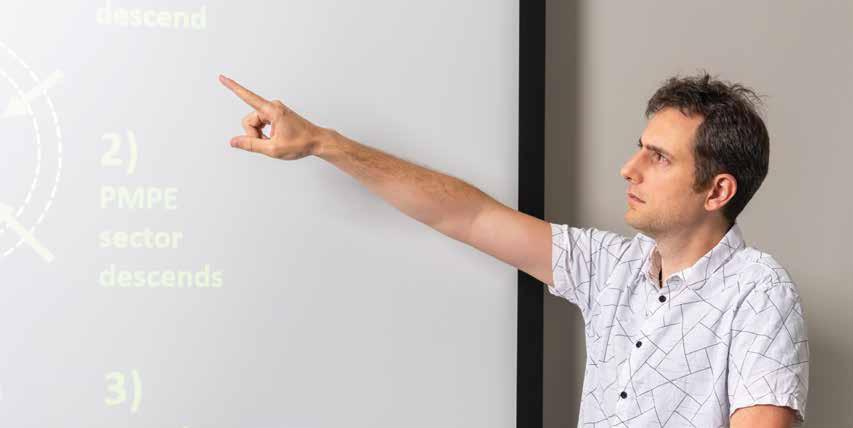
Agrawal will partner with local science museums and children’s centers, using Mechblocks, to expose K-12 students, parents and educators to materials, mechanics and structures that will help train the next generation of the STEM workforce.
“It’s difficult to convey these ideas in an exciting way,” Agrawal said. “These blocks provide a hands-on experience for students to see what happens when you’re breaking something.”
ORBITAL DEBRIS REMEDIATION
Guzzetti has earned a NASA Early Career Faculty award to research how to remediate the accumulation of smaller pieces of orbital debris. His project, “Metamaterial particles for orbital environment remediation,” spans three years and will research the feasibility of developing technology to deploy dust clouds to intercept small debris to reduce its altitude by inducing drag.
While still in the early phases of researching the topic and possibility of a solution, Guzzetti envisions the
distribution of engineered particulates in targeted regions of space to bring debris to the Earth’s atmosphere.
According to Guzzetti, there are currently two important categories of debris. There is larger debris, usually larger than 10 centimeters in diameter. These are typically trackable and could potentially be physically captured. Smaller debris, less than one centimeter in size, is more prevalent and more challenging to detect and track.
“What we are trying to solve is how to actively remove those smaller debris or facilitate their reentry into the atmosphere,” Guzzetti said.
Though Guzzetti said there may not be a single answer to the orbital debris remediation challenge, he is still excited to join the attempt at solving the issue, as well as help students obtain research experience.
“This allows me to engage with minds brighter than mine on these problems and expose them to orbital mechanics and the complexity of space,” he said.
19 DEAN’S REPORT 2023-24
BIOSYSTEMS
PROTECTING OCEANS AND LAKES FROM PHOSPHORUS RUNOFF
BY JEREMY HENDERSON
For Auburn’s Center for Bioenergy and Bioproducts (CBB), things are coming up roses ... and ryegrass.
That’s one of the model crops CBB researchers, along with a team of academic collaborators from the University of Delaware, New Mexico State University, Ireland and Northern Ireland, will use for a $1 million U.S. Department of Agriculture National Institute of Food and Agriculture (NIFA) project testing the efficacy of a dual-function biochar substrate — duobiochar they’re calling it — that captures excess phosphorus in soils and releases it slowly to meet plant needs.
The main idea is to ultimately keep the stuff out of oceans and lakes where too much phosphorus runoff from increasingly expensive synthetic fertilizers contributes to those large, oxygen-deprived “dead zones” — the Gulf of Mexico has one the size of New Jersey — you read about in the news.
“Biochar is a material made from plants through the thermochemical conversion of biomass,” said CBB director Sushil Adhikari, Alumni Professor in the Department of Biosystems Engineering. “It has micro-, meso- and macro-pore networks, functional groups and inorganic compounds that can absorb phosphorus. However, regular biochar isn’t usually made to distribute phosphorus to plants because fundamental science on the transient nutrient retention and release of biochar is lacking.”
At least, it’s lacking for now.
“Over the next year, our team will use state-of-the-art material characterization techniques to gain insight into slow phosphorus release properties in greenhouses and field trials conducted in Ireland and Northern Ireland,” Adhikari said.
In the Republic of Ireland and Northern Ireland, recent studies show high legacy phosphorus, applications



Sushil Adhikari Professor Director, Center for Bioenergy and Bioproducts
334-844-3543
Sza0016@auburn.edu aub.ie/SAdhikari
Wendiam Sawadgo
Assistant Professor
334-844-3538
wendiam@auburn.edu aub.ie/WSawadgo
Hossein Jahromi
Assistant Professor
334-844-1034
Hzj0048@auburn.edu aub.ie/HJahromi
saturating soils with phosphorus, which increasingly threatens water quality in the countries’ lakes.
Adhikari serves as the project’s principal investigator; co-PIs are Wendiam Sawadgo, extension professor in the College of Agriculture, and Hossein Jahromi, assistant research professor in the Department of Biosystems Engineering.
“Expanding the utility of biochar also has the potential to sequester carbon while providing agronomic benefits,” Adhikari said. “We feel this project can also help reduce the agriculture sector’s carbon footprint and address the impacts of climate change.”
20
COLLEGE OF ENGINEERING
SAMUEL GINN
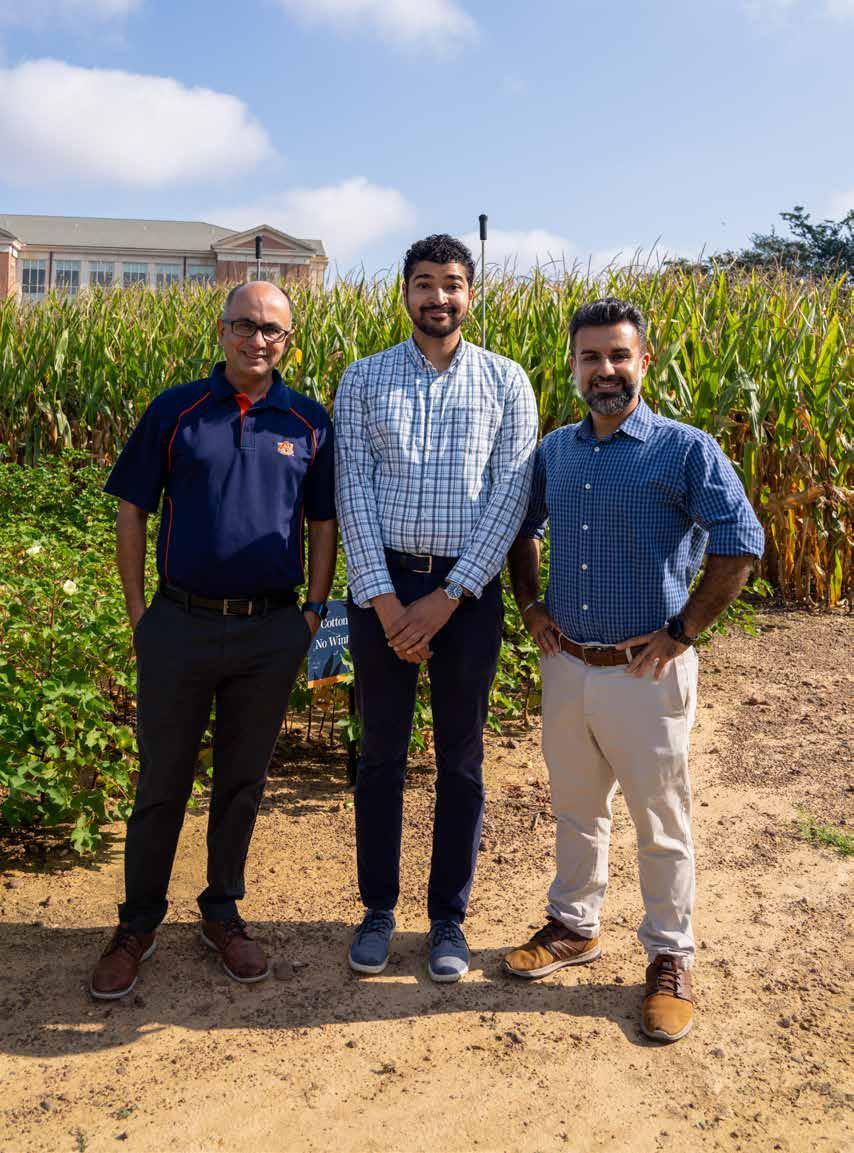
CHEMICAL REIMAGINING SUSTAINABLE DEVELOPMENT OF PLASTIC MATERIALS
BY JOE MCADORY
Mismanaged micro- and nano-plastics can threaten the environment and health. Three researchers in Auburn University’s Department of Chemical Engineering — Assistant Professor Symone Alexander, Department Chair Selen Cremaschi and Associate Professor Zhihua Jiang — offer solutions that could reimagine the sustainable development of plastic materials; address plastic waste challenges and its climate/health impacts; and build community climate resilience while advancing social and environmental justice in Mississippi and Alabama.
Their multi-disciplinary study, “Advancing social and environmental equity through plastics research: education, innovation and inclusion” (ASPIRE), is a collaborative effort with researchers from the University of Southern Mississippi, and part of a four-year, $4 million National Science Foundation — Department of Energy Established Program to Stimulate Competitive Research R-II Track-2 grant. These grants are awarded to researchers looking to advance climate change research and resilience capacity to expand opportunities for disproportionately affected communities.
“We’ve heard of islands of trash in the ocean, but what we don’t see are micro- and nano-plastics,” said Alexander, Auburn’s principal investigator (PI).
“Those are the very small particles that can easily be ingested by fish and marine animals, which we, as humans, ingest. This can lead to bioaccumulation that can cause other health issues which aren’t well studied.”
ASPIRE will develop advanced detection methods to analyze microplastic contamination in field and aquaculture samples, utilize novel methods to extend the lifespan and improve the performance of recycled products for sustained use, and design recyclable polymer thermosets using sustainable, bio-derived building blocks to establish chemistry-structureproperty relationships.
SAMUEL GINN COLLEGE OF ENGINEERING


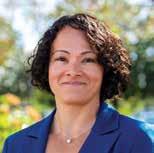
Zhihua Jiang
Auburn Pulp and Paper Foundation Associate Professor Director, Alabama Center for Paper and Bioresource Engineering 334-844-7829
Zzj0012@auburn.edu aub.ie/ZJiang
Symone Alexander
Assistant Professor 334-844-8626
Sla0044@auburn.edu aub.ie/SAlexander
Selen Cremaschi
Department Chair B. Redd & Susan W. Redd Eminent Scholar Chair Professor 334-844-4970
Szc0113@auburn.edu aub.ie/SCremaschi
They also want to address the lack of recyclable materials known as thermosets, like rubber and epoxy, which cannot be melted and formed into new materials after use.
How? With dynamic compatibilizers and lignin, an organic polymer found in plants that Alexander considers, “the glue that holds cellulose together.” In this case, lignin can be used to hold materials — such as plastics — together.
As a co-PI on the project, Cremaschi focuses on design optimization to assess economic feasibility and improve
22

the competitiveness of the team’s proposed solutions to the problem.
“Our role — working with collaborators — is to perform a techno-economic analysis to assess competitiveness of our proposed solutions among each other and against existing technologies,” she said. “Once we have the models in place for simulation of the processes, then we quickly study different processes to improve the techno-economic competitiveness of our solutions.”
Jiang, director of the Alabama Center for Paper and Bioresource Engineering, will serve as a senior personnel on the project and brings his vast understanding of lignin and experience in lignin separation to identify efficient lignin extraction processes.
Other ASPIRE thrusts include technology transfer and educational components in Mississippi and Alabama.
“We will both be working with industry partners for technology transfer, but we also want to showcase the latest technologies for these coastal communities,”
Alexander added, citing the Gulf Blue Initiative, a University of Southern Mississippi program which “pools the knowledge of research scientists, federal agencies, industry partners and entrepreneurs to further develop the region as a global leader in oceanand maritime-related technologies.”
Alexander is excited to make an impact on industry, society and health.
“Many of these health concerns affect people who look like me, or who come from a similar economic background,” she said. “They don’t always receive the same level of rigorous filtration when it comes to treating drinking water, or when it comes to addressing the lack of employment.
“It’s extremely important to me because communities that aren’t well served in terms of city planning, drinking water or availability of resources suffer most from health impacts related to pollution. A large part of this project is leading more in-depth studies on the impact of plastic pollution on waterways and health of coastal communities in Mississippi and Alabama.”
23 DEAN’S REPORT 2023-24

CIVIL AND ENVIRONMENTAL SAFEGUARDING THE GULF COAST ECOSYSTEM
BY DUSTIN DUNCAN
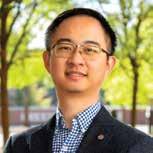
Shiqiang Zou
Assistant Professor
334-844-6393
shiqiang@auburn.edu
aub.ie/SZou
Stormwater runoff from urbanized areas flows directly into streams, creeks, rivers, lakes and oceans, carrying excessive pollutants including nutrients such as nitrogen and phosphorus.
Shiqiang Zou, assistant professor of civil and environmental engineering (CEE) and Michael Perez, associate professor in CEE, are collaborating on a three-year, $1.3 million project supported by the Environmental Protection Agency to upgrade geotextiles to filter excessive nutrients from stormwater runoff into the Gulf Coast ecosystem.
Zou said the project’s groundbreaking nature arises from its innovative design of a polylactic acid,
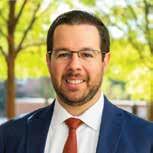
Michael A. Perez
Brasfield & Gorrie
Associate Professor 334-844-6267
Map0032@auburn.edu
aub.ie/MPerez
bioplastic-based geotextile embedded with metal oxides, which will remove phosphorus from stormwater runoff. Phosphorus and other nutrients can fuel the growth of harmful algal blooms that deplete oxygen levels, disrupt aquatic ecosystems and endanger aquatic life. While geotextiles are used at construction and industrial sites, Zou said they are primarily employed to control soil erosion while allowing rainwater runoff.
“If we can repurpose those geotextiles to not only prevent soil erosion but also use them as filters to retain nutrients in the water and prevent them from reaching the Gulf Coast, we would kill two birds with one stone,” Zou said.
24
COLLEGE OF ENGINEERING
SAMUEL GINN
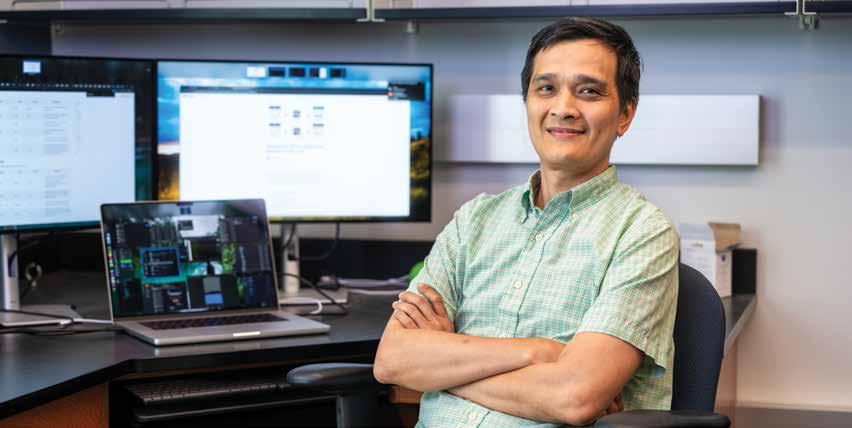
COMPUTER SCIENCE AND SOFTWARE
COMBATING CANCER SUBTYPE MISDIAGNOSES WITH DATA SCIENCE
BY JOE MCADORY
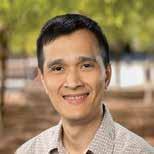
Tin Nguyen
Associate Professor 334-844-4359 tinn@auburn.edu aub.ie/TNguyen
More than 40,000 patients across the nation could die each year as a result of misdiagnoses — with 37.8 percent of those related to cancer, a British Medical Journal study revealed. A diagnosis, followed by treatment, for one cancer subtype might not be suitable for another.
Tin Nguyen, however, has a proposal. Not with novel treatment methods or medicine. Not with laboratory testing that’s capable of targeting specific genes. And not with specialized, high-tech medical equipment. Instead, Nguyen prefers a computer. A big computer.
The outcome: fewer fatalities, less suffering and reduced health care costs.
Nguyen earned a three-year, $1.2 million grant from the National Institutes of Health to find an ideal means of diagnosing cancer subtypes by means of data analysis — crunching years’ worth of laboratory discoveries and experiments and apply those to patients’ personalized pathway profiles. The result will create, among other deliverables, a complete analysis pipeline and web application able to integrate studies from multiple focuses.
“With computer science, you can collect data from multiple cancer-related experiments from the past decades and put them together,” said Nguyen, associate professor in the Department of Computer Science and Software Engineering and director of the Bioinformatics Lab at Auburn University.
“My solution is that we put data collected from these experiments into one analysis. That way we are not biased toward any study, and we are not biased toward any method or any type of molecular data. We can potentially have a complete picture. Then we can try to see treatments, or diseases, from many different aspects that one experimenter cannot do.”
25 DEAN’S REPORT 2023-24

ELECTRICAL AND COMPUTER
EXPLORING SECURITY SOLUTIONS FOR SEMICONDUCTOR SUPPLY CHAINS
BY JOE MCADORY
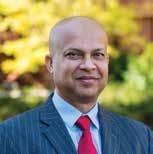
Ujjwal Guin
Godbold Associate Professor 334-844-1835
Ujjwal.guin@auburn.edu
aub.ie/UGuin
Rapid advancements in the semiconductor industry have enabled the broad adoption of electronics into multiple sectors of society, including commercial, industrial and defense spaces, often improving quality of life while increasing business efficiency. That’s the good news.
The globalization of electronics, however, opens a Pandora’s box of threats with untrusted products, counterfeit integrated circuits, intellectual property piracy, cloning and other malicious modifications. That’s the bad news.
Ujjwal Guin, the Godbold Associate Professor of electrical and computer engineering, has an idea that
SAMUEL GINN COLLEGE OF ENGINEERING
could help resolve some of these potential issues. His co-authored proposal, “Securing semiconductor supply chains and networks using zero-knowledge proofs and blockchain,” earned a $1.8 million grant from the Air Force Office of Scientific Research (AFSOR). He is joined by co-PIs from the University of Southern California, Cornell and Tel-Aviv Universities.
“The primary objective of this proposal is to develop novel solutions using zero-knowledge proofs and blockchain technologies to enable security in electronic hardware, as well as to enable routing data securely over dynamic communication networks,” Guin said.
“Our objective is to integrate zero-knowledge proofs into blockchain to address various hardware and network threats.”
Guin said these proofs help secure the Internet of Things and cyber-physical systems against malicious adversaries by creating zero-knowledge properties, allowing an adversary to “learn nothing.” In the meantime, the proof protocol “can effectively identify the adversaries with inherent properties.”
26

INDUSTRIAL AND SYSTEMS
PREDICTING ADDITIVE MANUFACTURING FATIGUE THROUGH DEEP LEARNING
BY JEREMY HENDERSON

Jia (Peter) Liu
Assistant Professor 334-844-1428
Lzj0040@auburn.edu aub.ie/JLiu
Five years ago, GE Aerospace transitioned to using additive manufacturing (AM) for its new catalyst turboprop engine, which meant that 800 traditionally manufactured components were consolidated into just 12 metal AM parts. In that time, the development cycle was dropped to two years, the engine weight reduced by 5% and the fuel consumption improved by 1%. For G.E., that’s a big deal. If other U.S. aircraft manufacturers went the same route, that would be big deal for the planet.
There’s a reason AM research across the globe is expected to push $24 billion by 2027, and the revolutionary impact on the aviation industry is one of them. Experts estimate that substantial adoption of
3D-printed parts could knock 200 million gallons off of annual aviation fuel consumption. If the parts work.
Despite the demonstrated success of metal additive manufacturing in various industries, the performance uncertainty of AM parts undermines the potential of deploying AM for high-consequence applications, such as air travel and space travel.
That is why the National Science Foundation is turning to Peter Liu, assistant professor of industrial and systems engineering, in the form of a $500,000 CAREER Award meant to generate new insight into defect formation relevant to fatigue performance of parts manufactured through laser powder-bed fusion and uncover the synergistic impacts of multi-scale factors on fatigue fractures.
Liu’s project will establish a physics-centric, machine learning framework for fatigue life predictions, serving as a technological foundation for future metal AM production of dynamic load-bearing applications and establishment of a resilient and reconfigurable supply chain, enhancing the competitiveness of U.S. industry.
27 DEAN’S REPORT 2023-24

MATERIALS
SYNTHESIZING 2D MATERIALS FOR NOVEL ENERGY APPLICATIONS
BY JEREMY HENDERSON
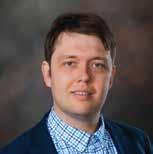
Konstantin Klyukin
Assistant Professor
334-844-4877
kylukin@auburn.edu aub.ie/KKlyukin
The National Science Foundation awarded Konstantin Klyukin, assistant professor of materials engineering, $1.2 million through its Designing Materials to Revolutionize and Engineer our Future program, which funds research into “novel materials to address grand societal challenges.” And these days, few materials are more novel — or hold more potential for addressing societal challenges — than 2D materials.
“Materials such as graphene and MXenes usually serve as building blocks for many technologies, including batteries, computing devices, wearable nanoelectronics, purification membranes and sensors,” Klyukin said. “The discovery of graphene won the Nobel Prize, and the possibilities of another major discoveries
such as MXenes and transition-metal dichalcogenides always sparks a lot of excitement in the scientific and engineering communities.”
The goal of Klyukin’s project, “Computationally driven discovery and synthesis of 2D materials through selective etching,” is to spark even more.
“I’m aiming to expand beyond the commonly studied 2D materials with weak interlayer interactions through selective electrochemical extraction of atoms from layered 3D structures,” he said.
Klyukin said the project will draw upon the expertise of a multidisciplinary team of chemists, physicists and materials scientists utilizing state-of-the-art computational, experimental and machine-learning techniques in a closed-loop paradigm inspired by the Materials Genome Initiative.
“This funding provides an opportunity for us to advance the synthesis of existing 2D materials and hopefully accelerate the discovery of novel 2D materials that can revolutionize everyday technologies,” Klyukin said.
28 SAMUEL
ENGINEERING
GINN COLLEGE OF

MECHANICAL
AUBURN CENTER’S FHE REPUTATION UNDERSCORED WITH MULTIPLE WINNING ADDITIVELY MANUFACTURED ELECTRONICS PROPOSALS
BY JEREMY HENDERSON

Pradeep Lall
John and Anne MacFarlane Endowed Distinguished Professor Alumni Professor Director, NSF Center for Advanced Vehicle and Extreme Environment Electronics (CAVE3) 334-844-3424
lall@auburn.edu
aub.ie/PLall
If you’re trying to gauge Auburn’s preeminence in harsh environment electronics resiliency development and flexible hybrid electronics (FHE) research, look no further than the latest project call of the NextFlex National Manufacturing Institute.
In the Project Call 7 competition, there were two winning Auburn proposals. In the current Project Call 8? Three, collectively funded at $2.5 million with 1:1 cost-share — all focused on additively manufactured (AM) FHE, all competitively won by teams led by Pradeep Lall, the MacFarlane Distinguished Professor and Alumni Professor of mechanical engineering and
director of Auburn University’s Center for Advanced Vehicle and Extreme Environment Electronics (CAVE3).
Under Lall’s 15-year leadership, CAVE3 has grown exponentially. In 2015, Lall led the Auburn team contributing to the winning proposal that resulted in the foundation of the NextFlex National Manufacturing Institute. Auburn is a tier-1 founding member of NextFlex, whose mission is to advance U.S. manufacturing of FHE; Lall serves on the NextFlex technical council and has previously served on the governing council of the institute.
The design of electronics for operation in harsh environments has long been an area of research for both Lall and CAVE3. While earning an international reputation for designing electronics for operation in harsh environments relative to automotive, military, defense and downhole applications, CAVE3 also accelerated the growth of the flexible hybrid electronics industry itself. Lall expects the three programs to also benefit CAVE3’s leading work toward developing FHE reliability standards.
29 DEAN’S REPORT 2023-24

WIRELESS
USING FUNCTIONAL DATA ANALYSIS-AIDED LEARNING METHODS TO IMPROVE WIRELESS MEASUREMENTS
BY JOE MCADORY

Shiwen Mao
Professor and Earle C. Williams
Eminent Scholar Chair Director, Wireless Engineering Research and Education Center
(334-844-1845) smao@auburn.edu aub.ie/SMao
Shiwen Mao, director of the Wireless Research and Education Center, is principal investigator on a $400,000 National Science Foundation grant “Functional data analysis-aided learning Methods for robust wireless measurements.”
Along with co-PI Guanqun (Vivian) Cao, associate professor in the Department of Mathematics and Statistics, and Dr. Xuyu Wang with Florida International University, Mao aims to develop a deep learning-based approach to address fundamental regression problems in functional data; a better understanding of functional data regression and classification under the distribution between test data and training data for effective wireless measurements in dynamic environments;
a deep learning-based approach to address the fundamental bottleneck of quantile regression-based methods; and wireless measurement applications for integration and validation.
This was just one of three NSF-funded grants that Mao, the Earle C. Williams Scholar, was awarded in summer of 2023, combining for $2.2 million.
“NSF programs are known to be very competitive,” said Mao. “One effective approach to get funded is simply to submit more proposals. If you do not submit any, the chance of funding will be zero. Another approach I tried is exploring a variety of programs. Don’t keep focusing on just the core program of your field. My area of expertise is wireless engineering, but I also submitted to education, outreach and diversity programs.
“Lastly, quality of research is very important. One way to improve your quality of research is to collaborate with colleagues across colleges and universities, who often share a variety of viewpoints and bring in complementary expertise that help broaden the scope and strengthen the depth of the proposal.”
30 SAMUEL GINN COLLEGE OF ENGINEERING

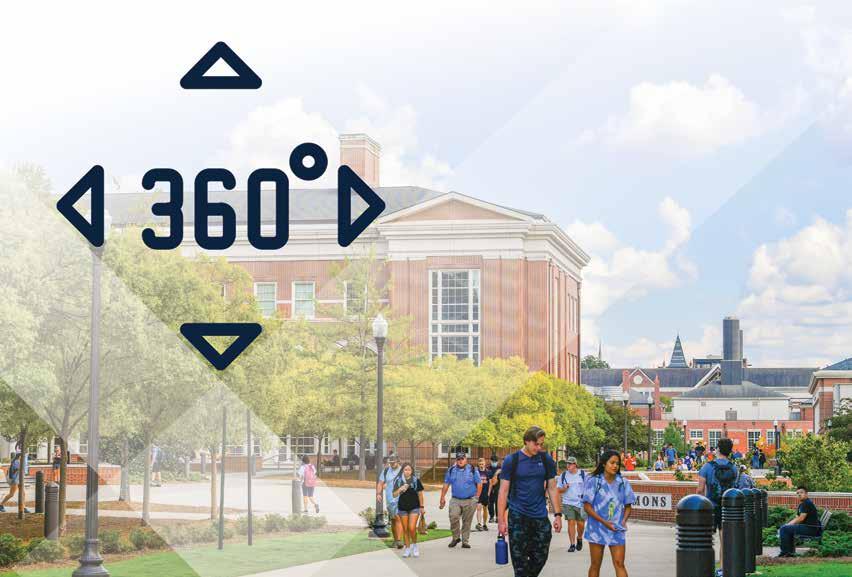

VISIT OUR CAMPUS! TAKE AN ENGINEERING VIRTUAL TOUR aub.ie/360engtour SCAN ME SEARCH #GINNING ON THE APPS ABOVE /// ENG.AUBURN.EDU/GINNING THE BEST PODCAST IN HIGHER EDUCATION
FACULTY HIGHLIGHTS
Adil Bashir, associate professor of electrical engineering, is the co-investigator on a $5.3 million grant from the National Institutes of Health. In collaboration with researchers from the University of AlabamaBirmingham’s Department of Psychiatry, Bashir is aiming to characterize brain aging phenomena in schizophrenia spectrum disorders.
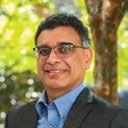
Rob Jackson, Albert Smith Jr. Professor of mechanical engineering, was selected as editor of the Journal of Tribology, a prestigious publication from the American Society of Mechanical Engineers’ Tribology Division.

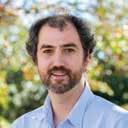
Bryan Beckingham, associate professor of chemical engineering, co-edited a new book with a collaborator from Tuskegee University entitled “The Renewable EnergyWater-Environment Nexus: Fundamentals, Technology, and Policy.” The book describes the connections between renewable energy, water and the environment, and then discusses the interrelationships (and opportunities) between renewable energy systems, environmental systems and societal needs for water. This book leveraged expertise of an international group of authors including Cassandra Porter and Lauren Beckingham at Auburn University. Beckingham was also elected to the leadership line for the Materials Engineering and Science Division (MESD) of the American Institute of Chemical Engineers at the Fall National Meeting in Orlando, Florida. He will serve as 2nd vice chair for 2023-2024, followed by vicechair and chair in subsequent years.
Robert Dean, the McWane Endowed Professor in electrical and computer engineering, received the Outstanding Educator Award for 2023 from the International Microelectronics Assembly & Packaging Society (IMAPS).
Roy Hartfield, the Walt and Virginia Woltosz Professor of aerospace engineering, won the 2023 AIAA Aerodynamics Award from the Huntsville chapter of the American Institute of Aeronautics and Astronautics.


Shubhra Karmaker, assistant professor of computer science and software engineering, received a $700,854 basic research grant as the lead principal investigator from the National Science Foundation. Karmaker also received a $542,485 basic research grant as the sole principal investigator from the Air Force Office of Scientific Research.

Konstantin Klyukin, assistant professor of materials engineering, is the principal investigator on a $2 million project from the National Science Foundation titled “DMREF: Computationally Driven Discovery and Synthesis of 2D Materials through Selective Etching.” The award will advance knowledge frontiers required to develop a very selective electrochemical removal process for the synthesis and discovery of novel 2D materials. Auburn University will lead the project in partnership with University of Arizona, Missouri S&T and Tuskegee University.

Joe Majdalani, the Hugh and Loeda Francis Chair of Excellence in the Department of Aerospace Engineering, delivered the 2023 von Kármán Lecture in Astronautics, hosted by the American Institute of Aeronautics and Astronautics (AIAA). He was also named the recipient of the 2024 Wyld Propulsion Award from AIAA, the organization’s highest distinction in propulsion, awarded for outstanding achievements in developing or applying rocket propulsion systems. The AIAA also awarded him the organization’s Abe M. Zarem Educator Award.

32
COLLEGE OF ENGINEERING
SAMUEL GINN
Shiwen Mao, the Earle C. Williams Eminent Scholar, professor of electrical and computer engineering, and Director of Wireless Engineering Center, won the IEEE Communications Society (ComSoc) Multimedia Communications Technical Committee (MMTC) Outstanding Researcher Award in December 2023, and two Best Paper Awards from the 2023 IEEE Global Communications Conference (GLOBECOM’23), Kuala Lumpur, Malaysia in December 2023.
Stephen Mills, Auburn University Applied Research Institute principal research scientist, is the principal investigator of a $1.1 million award supporting the U.S. Army Redstone Test Center’s Mission Based – Multi Domain Operations Test Environment.


of the International Union of Laboratories and Experts in Construction Materials, Systems, and Structures (RILEM), a world-renowned association aimed to promote scientific cooperation in the area of construction materials and structures since its establishment in 1947.
Michael Zabala, Auburn Alumni Engineering Council Associate Professor of mechanical engineering, along with former graduate students, was awarded a U.S. patent for “Methods for Manufacturing Individualized Protective Gear from Body Scan and Resulting Products.”



Larry Rilett, the Samuel Ginn College of Engineering Distinguished Professor and director of the Auburn University Transportation Research Institute, was honored with the Steinberg Award by the American Road and Transportation Builders Association (ARTBA), which annually recognizes “an individual who has made remarkable contributions to transportation education and research.”
Fan Yin, associate research professor and assistant director of the National Center for Asphalt Technology, was awarded five research projects (as the principal investigator) from Equistar Chemicals LP, the Minnesota Department of Transportation, the New Mexico Department of Transportation and the Ohio Department of Transportation, totaling $1.55 million in funding. Yin was also elected to co-chair the Technical Committee on Alternative Paving Materials – Design and Performance

Xinyu Zhang, Alumni Professor of chemical engineering, is the principal investigator on a team of researchers developing innovative, costeffective and portable opioid biosensors utilized by patients, medical professionals and law enforcement, capable of providing immediate and accurate opioid detection and monitoring. The project, “An Integrated and Miniaturized Opioid Sensor System: Advancing Evidence-Based Strategies for Addressing the Opioid Crisis,” was awarded $649,585 from U.S. National Science Foundation (NSF) Convergence Accelerator, Track L: Real-World Chemical Sensing Applications.
Huaguo Zhou, the Elton Z. and Lois G. Huff Professor of civil and environmental engineering, co-authored a handbook aimed at helping state Department of Transportation offices reduce the risk of wrong-way driving crashes.
Shiqiang Zou, assistant professor of civil and environmental engineering, has been appointed as an associate editor for the international journal, Desalination and Water Treatment. He is one of only two editors representing the United States on the editorial board.


33 DEAN’S REPORT 2023-24
NEW FACULTY MEMBERS


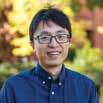



Sathyanarayanan “Sathya” Aakur | Oklahoma State University / University of South Florida
Assistant Professor | Computer Science and Software Engineering
My research interests include building intelligent agents at the intersection of computer vision, natural language processing and psychology. The goal is to advance knowledge of how computers can learn with minimal human supervision to perceive events in videos.
Sanchuan Chen | Ohio State University
Assistant Professor | Computer Science and Software Engineering
My research interests range from software security to machine learning security. I am interested in using the language model techniques in building AI agents for program analysis, testing and verification. My other interests include hardware security and quantum computing.
Zihe Gao | University of Pennsylvania / University of Illinois
Associate Professor | Electrical and Computer Engineering
My research is focused on developing advanced photonic devices and systems for imaging and computing to meet the requirements of technologies such as wearable and autonomous systems. Our approach leverages the integration of photonic and microelectronic chips to achieve compact, robust and scalable solutions.
Ali Ghanbari | University of Texas Dallas / Iowa State University
Assistant Professor | Computer Science and Software Engineering
My research focuses on the use of programming language and machine learning techniques to solve software problems related to testing, verification and repair. I am known for my works in program repair and fault localization.
Pan He | University of Florida
Assistant Professor | Computer Science and Software Engineering
My research focus is mainly in computer vision, machine learning and smart infrastructure by developing fundamental AI techniques and integrating them to support downstream applications in next-generation infrastructure systems.
Edward Huang | George Mason University
Assistant Professor | Industrial and Systems Engineering
My research is dedicated to the design aspect of digital engineering and the analysis of supply chains, both legitimate and illicit contexts. My work investigates various illicit supply chains, including networks associated with counterfeit pharmaceuticals, insider threats and border security.
34 SAMUEL GINN COLLEGE OF ENGINEERING

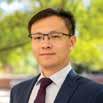



Bosen Lian | University of Texas at Arlington
Assistant Professor | Electrical and Computer Engineering
My research efforts are in distributed estimation, distributed control, reinforcement learning, game theory and their intersections in control systems. My primary objective is to design safe, optimal and resilient multiagent systems, and to solve data-driven control solutions.
Wen Luo | Northwestern University / CalTech
Assistant Professor | Aerospace Engineering
My research seeks to manufacture reliable structures for a space era affordable to all. I aim to push forward the understanding of the stochastic failure of aerospace structures and materials, and develop reliable composite structures for extreme environments using additive manufacturing.
Tin Nguyen | University of Maryland
Associate Professor | Computer Science and Software Engineering
My research interests include the development of statistical and computational methods that can be applied to systems biology, health care and cancer research. My research laboratory focuses on developing novel methodologies for the analysis and integration of multi-omics and single-cell data.
Yazhou Tu | University of Louisiana at Lafayette
Assistant Professor | Computer Science and Software Engineering
Intelligent and autonomous cyber-physical systems (CPS), such as robotic systems, autonomous vehicles and medical devices, are rapidly emerging; these systems rely on sensor-enabled environment perception. My research investigates how the security and safety of such CPSs require threat models resilient to the complex physical world.
Rongxuan Wang | Virginia Tech
Assistant Professor | Industrial and Systems Engineering
My expertise is in laser powder bed fusion related instrumentation, process monitoring and control. My aim is to provide advanced manufacturing solutions for mission-critical components.
35 DEAN’S REPORT 2023-24 35

STUDENT HIGHLIGHTS
Azeez Adekunle Adebayo, doctoral student in mechanical engineering, received the Graduate Research Scholars Program (GRSP) award through the Alabama Established Program to Stimulate Competitive Research (ALEPSCoR).
Yeonjin Baek, doctoral student in materials engineering, took home the grand prize in Japanese research technology company JEOL’s annual scanning electron microscope (SEM) image contest.
Chemical engineering student team won the international American Institute of Chemical Engineers Student Conference Chem-E car championship.
Parvin Fathi-Hafshejani, doctoral student in electrical and computer engineering, took third place at the SEC Student Pitch Competition.
Matthew Freestone and Hugh Williams, senior and junior in computer science and software engineering respectively, were recognized by the Computer Research Association as two of its Outstanding Undergraduate Researchers for 2023-24.
Ethan Hughes, a senior in electrical and computer engineering, received a 2023-24 Institute of Electrical and Electronics Engineers (IEEE) Power and Energy Society Scholarship Plus Initiative award.
Ayden Kemp, senior in aerospace engineering, was awarded an Astronaut Scholarship Foundation scholarship.
Jada Neal, senior in bioprocess engineering, was named one the university’s inaugural Matthews Scholars Program fellows, a collaboration between the Honors College, the Office of Inclusion and Diversity and the Office of Undergraduate Research in honor of the legacy of Dr. Josetta Brittain Matthews, Auburn’s first African American graduate and first African American faculty member.
Minas Pantelidakis, doctoral student in industrial and systems engineering, was named the 2023 JT Black Lean Engineering Student of the Year, which exemplifies leadership by demonstrating a deep desire to learn and a commitment to continuous improvement.
Kanak Parmar, doctoral student in aerospace engineering, won the Molly K. Macauley Award from the American Astronautical Society.
Manish Sakhakarmy, doctoral student in biosystems engineering, placed first in the oral/poster competition at the ASABE Annual International Meeting.
Elizabeth Weidl, senior in aerospace engineering, was the 2023 south central region winner and national runner-up for the Sigma Gamma Tau Undergraduate Award.
Katie Wolfe, an Honors College senior double majoring in theatre design and technology and electrical engineering, won first place for her presentation in the Honors Scholar section of the 101st Alabama Academy of Science Conference.
36 SAMUEL GINN COLLEGE OF ENGINEERING
FALL 2023
1,362 214
Incoming first-time freshman students
Incoming transfer students
$5.3 MILLION
28.8
4.15 AVERAGE ACT GPA

support awarded
scholarship
THE BEST STUDENT-CENTERED EXPERIENCE IN AMERICA
37 DEAN’S REPORT 2023-24
AEROSPACE ENGINEERING STUDENT WINS PRESTIGIOUS CHURCHILL SCHOLARSHIP
BY WADE BERRY

Maggie Nelson is Auburn University’s first Churchill Scholarship recipient.
Nelson, a senior from Birmingham in the Department of Aerospace Engineering, is headed to Churchill College at the University of Cambridge this fall to work toward a master’s in materials science and metallurgy.
In addition to her aerospace engineering degree from the Samuel Ginn College of Engineering, Nelson, an Honors College student, will graduate with minors in materials engineering, philosophy and sustainability studies in the College of Liberal Arts.
The Churchill Scholarship is the latest of several awards Nelson has achieved at Auburn. She has also won two Astronaut Scholar Awards, the German Exchange DAAD RISE Award and the Barry M. Goldwater Award.
“It feels like a little much, but I’m honored and thankful,” Nelson said. “I would like to thank all the people who supported me through my undergraduate journey at Auburn. Winning these awards is a testament to building a tolerance for failure, but I’m always trying.”
Brian Thurow, chair of the Department of Aerospace Engineering said Nelson’s work ethic is unquestionable
and personifies what it means to be an Auburn student.
“Maggie is the personification of the Auburn Creed, particularly where it reads, ‘I believe in work, hard work,’” Thurow said. “While her performance in the classroom has been truly outstanding, we have always emphasized the importance of quality experiences outside of the classroom. This is where I think Maggie has truly shined.”
While at Cambridge, Nelson will research ways of improving the efficiency of solar energy cells in interior light. She hopes to apply this knowledge to earth and space-based solutions for sustainable energy production.
The Churchill Scholarship is an annual award given to only 16 students in the U.S. to study at Churchill College in Cambridge. The scholarship is regarded as one of the nation’s most prestigious awards.
Established at the request of Sir Winston Churchill as part of the founding of Churchill College, the Churchill Scholarship fulfills his vision of deepening the US–UK partnership to advance science and technology on both sides of the Atlantic, ensuring our future prosperity and security.
38 SAMUEL GINN COLLEGE OF ENGINEERING
DOCTORAL STUDENT IN MECHANICAL ENGINEERING WINS $50,000 AT ALABAMA LAUNCHPAD PITCH COMPETITION
BY JOE MCADORY
Will Bryan, who is pursuing a doctoral degree in mechanical engineering, won first place and $50,000 in December at Alabama Launchpad’s early-seed stage Cycle 3 pitch competition final round in Birmingham.
Bryan is the CEO and founder of Autonoma, which creates autonomous vehicle and simulation validation tools. The startup combines an autonomous vehicle simulator with high-bandwidth, low-latency wireless communications to allow a real vehicle to “see” a virtual environment around it — allowing for safer transitions from simulation to on-road operation and is less expensive/more efficient than current validation methods.
“Participating in Launchpad was a great experience. As a first-time founder there are a lot of unknowns, so it is crucial to learn from the experiences of others while still being true to myself,” said Bryan, who competed in Alabama Launchpad’s Cycle 2 final round Aug. 17 at Auburn University’s New Venture Accelerator.
“Launchpad provides great mentors and a startup ecosystem that have been an excellent resource as we build a great product and bring it to market,” he said. “We are also beginning to raise a seed investment round, so using the Launchpad advisors to strategize our fundraising and provide introductions has been huge. Winning first place and taking home $50,000 is the whipped cream on top of an already extremely valuable experience. It provides valuable capital as we are growing and gets our name in front of more people.”
Bryan’s interest in the automated vehicle world blossomed in Auburn Engineering’s GPS and Vehicle Dynamics Laboratory during his pursuit of a master’s degree in mechanical engineering. He also served as the Autonomous Tiger Racing team lead.
“At Autonoma, we have been working hard to make scalable simulation tools that close the gap between simulation and reality,” Bryan said. “As we move

forward, we are expanding to bring our simulation to new automated industries such as defense, warehouse robotics, drone delivery, logging, mining, trucking and more. Additionally, we are working to blend the lines between software simulation and real-world operation with our augmented reality solution that allows us to test the most dangerous and rare edge cases on real vehicles for the first time. We are currently fundraising to help us achieve these goals and continue our mission of increasing the safety of autonomous systems.”
Zakariya Veasy, a senior in computer science and software engineering, was among four entrepreneurs to present in the competition’s concept stage division. His business idea, OMNIS, merges blockchain technology with traditional banking to empower users with peer-topeer loans, credit building and seamless transactions. The concept stage division, however, was ultimately won by DevClarity, an artificial intelligence-powered platform for proactive developer management.
Since 2006, Alabama Launchpad has funded 117 Alabama startups and awarded more than $6 million in non-dilutive funding to winning companies, which boasts a combined post-money valuation of more than $1 billion and employ more than 1,300 people.
39 DEAN’S REPORT 2023-24
ENSURING ENGINEERING’S FUTURE
The Samuel Ginn College of Engineering is committed to providing the best student-centered engineering experience in America. Our Keystone Society donors are a strategic part of this vision, providing much-needed annual funds to the college. These funds enhance engineering education and allow the college to remain nimble and tackle any unexpected challenges.
26.9% 73.1% of all funds raised were spendable of all funds raised were endowed
STRATEGIC LEADERSHIP TEAM
The Strategic Leadership Team exists to help move the Samuel Ginn College of Engineering’s highestlevel strategic priorities forward. Since it was established, the team has contributed more than $189 million to propel these priorities.
LARGEST AREAS OF SUPPORT
Scholarships:
The Samuel Ginn College of Engineering provided more than $5.3 million in engineering scholarships in the 2023-24 academic year supporting a total of 1,384 students.
44.3% of funds received went to scholarships — a total of $13.3 million raised toward the total endowment.
Programmatic:
The college raised $9.6 million for programmatic support. These funds are mostly unrestricted Funds for Excellence, which allow the deans and department chairs to meet priority goals for the college.
WHO ARE AUBURN ENGINEERING’S DONORS?
2,622 DONORS gave
6,309 GIFTS in fiscal year 2023, for a total of $30.2 MILLION funds raised in fiscal year 2023
40 SAMUEL GINN COLLEGE OF ENGINEERING
Parents FriendsCorporations Faculty/Staff Alumni Other
THE BEST STUDENT-CENTERED ENGINEERING EXPERIENCE IN AMERICA
Why do students choose Auburn Engineering?
UNDERGRADUATE RESEARCH
Opportunities abound for students to gain experience in Auburn Engineering’s many cutting-edge research facilities. Students are able to conduct undergraduate research while collaboratively working with faculty, graduate students and fellow undergraduate students.
CENTER FOR INCLUSIVE ENGINEERING EXCELLENCE
The Center for Inclusive Engineering Excellence is an academic support and professional development program for engineering students. This program works toward increasing the recruitment and enhancing the retention of underrepresented engineering students.
STUDENT ORGANIZATIONS
Student organizations offer a wide variety of fun and educational opportunities — from student chapters of professional groups and honor societies to student competition teams and campus-wide organizations such as band, intramural sports and student government.
CAREER DEVELOPMENT AND CORPORATE RELATIONS
From resume enrichment to assistance with interviewing skills, negotiating a job offer and everything in between, the Office of Career Development and Corporate Relations is staffed with career professionals ready to help students gain real engineering work experience before graduation and beyond.
ENGINEERING GLOBAL PROGRAMS
Auburn Engineering offers a wide range of facultyled global programs, exchange programs and service learning such as Engineers Without Borders, which provides deeply meaningful opportunities to

students wanting to use their engineering skills to help developing communities in Bolivia and Guatemala meet basic human needs. Another example? The Biomechanics and Engineering in the Arts program in Italy teaches the biomechanical roots of ballet, the symphony, opera and even painting by exploring the engineering influence of Renaissance artists.
SUPPORT FOR WOMEN IN ENGINEERING
The college supports the advancement and success of female engineers in a variety of ways. The Society of Women Engineers and Alpha Omega Epsilon are organizations that empower women to succeed and advance in the field by offering speakers and networking opportunities at monthly meetings. In addition, the college’s 100+ Women Strong program seeks to recruit, retain and reward female engineering students. The 100+ Women Strong program is made up of alumni and friends of the college who recognize the importance of connecting with the next generation of female engineers.
K-12 OUTREACH OPPORTUNITIES
From hands-on activities and summer camps to E-Day, the college’s annual engineering open house, the Office of Recruitment, Outreach and Scholarship employs exciting and engaging programming year round that exposes K-12 students to the world of engineering.
41 DEAN’S REPORT 2023-24
RESEARCH CENTERS

AUBURN RESEARCH CENTER RENAMED WITH RENEWED FOCUS ON NEUROIMAGING
A major research center within Auburn’s Samuel Ginn College of Engineering has been renamed the Auburn University Neuroimaging Center to highlight its renewed focus on solving critical neurological health challenges.
The center — headquartered in the Thomas Walter MRI Research Building in the Auburn Research Park — is focused on advancing the latest in neuroscience research and leveraging the university’s expertise in engineering, sciences and veterinary medicine with the use of advanced magnetic resonance imaging.
“Our vision is to become a leading center for MRI research with emphasis on brain imaging,
cardiovascular imaging and orthopedic imaging,” said Thomas Denney, director of the Auburn University Neuroimaging Center and the Mr. & Mrs. Bruce Donnellan & Family Endowed Professor in electrical and computer engineering.
“These areas represent an intersection between the needs of the MRI research community and existing expertise and strengths of Auburn University.”
The center will allow the university to expand its groundbreaking brain research, among other capabilities, through the MRI devices at the site and the academic and research prowess of Auburn faculty.
“I dreamed of building an MRI research program here at Auburn where large medical centers recognize our contributions,” Denney said. “Through research, Auburn University has moved the needle and more
42
OF ENGINEERING
SAMUEL GINN COLLEGE
than exceeded my expectations. Since opening this building, we’ve been able to double our staff. Those (MRI) machines are great, but people are the ones who write research papers and earn those research grants. The university is sitting on a gold mine in terms of data and capabilities.”
Approximately 90 percent of the images processed at the center focus on the brain.
“The neuroimaging center is a blessing to my practice and to our student-athletes because we literally use it on a daily basis, including the weekend,” said Michael Goodlett, chief medical officer and team physician for Auburn Athletics. “It gets us back to play quicker because not all injuries are surgical, and this definitely helps us determine very quickly in the course what’s surgical and what’s not surgical.”
Jennifer Robinson, professor of psychological sciences, said her research work also has benefited greatly from the center.
“I’m particularly focused on the interaction between cognition and emotion,” she said. “So, disorders like post-traumatic stress disorder are of great interest to me. And then also just knowing how much that can help our soldiers and folks that have experienced PTSD.”
New research already underway include, but are not limited to:
-Meredith Reid, assistant professor in electrical and computer engineering, who is exploring posttraumatic stress disorder biomarkers in senior adults via spectroscopy.
-Adil Bashir, associate professor in electrical and computer engineering, who is studying muscle and brain energy production capacity on the cells and determining mitochondrial metabolic homeostasis by utilization of phosphorus spectroscopy.
-Gopikrishna Deshpande, professor in electrical and computer engineering, who is examining how artificial intelligence can be used to predict brain disorders and human/animal behavior using information from brain networks via MRI.
MCCRARY INSTITUTE AT AUBURN UNIVERSITY ANNOUNCES NEW PODCAST
The McCrary Institute for Cyber and Critical Infrastructure Security announced the rollout of a new podcast, part of the institute’s new strategic plan to make the research institute a destination for all things related to cybersecurity.
Recently, the institute released new videos with guests who include: Chris Inglis, the first national cyber director; Melissa Hathaway, a former advisor to Presidents George W. Bush and Barack Obama; former CEO of Southern Company Tom Fanning; and cybersecurity reporters from CNN and Politico.
“The success we’ve already had with our podcast is humbling,” said Frank Cilluffo, director of the McCrary Institute. “It is something where anybody can tune in and hopefully learn a thing or two on cyber.”
The release comes on the heels of the announcement of new senior fellows at the institute, who include experts in artificial intelligence, cybercrime, cloud computing, ransomware, infrastructure resiliency, national security and other expertise. They include former deputy directors of the NSA and FBI as well as executives at the Walt Disney Company and Google.
Cilluffo said the new media products, including the podcast, and the new senior fellows are part of a broader push by the institute and Auburn University to make the country safer from cyberattacks.
“Universities have an opportunity and, dare I say, a responsibility to make our country and Alabama more secure and resilient to cyber attacks,” Cilluffo said. “Auburn is stepping up with its resources including its world-class faculty researchers as well as its engineering and business prowess which positions us to play an important role.”
43 DEAN’S REPORT 2023-24
@AuburnEngineers
WAREAGLE Non-profit Org. U.S. Postage PAID Permit No. 9 Auburn, AL 1301 Shelby Center / 1161 W. Samford Ave., Building 8 Auburn, AL 36849-0001 ENG.AUBURN.EDU
@AuburnEngineering @auburnengineers
@AuburnEngineers linkedin.com/school/auburnengineering eng.auburn.edu/flickr




















































































